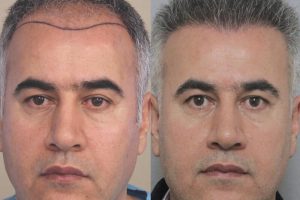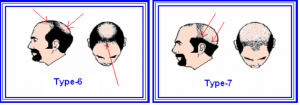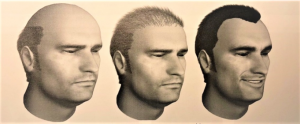WHAT ARE MY MEDICAL THERAPY OPTIONS?
We generally classify the medical therapies for Andro Genetic Hair fall in three main topics:
Medicines & Products
We prescribe some oral (Finasteride tb) and topical (finasteride & minoxidil) medicines and multi vitamins & some hair care products to stop hair fall and stimulate the hair regrowth.
Laser Therapy
Laser is one of the most powerful treatment modalities in the world. The scientific background for this therapy is to stimulate tissue regeneration by light energy. It is approved by US Food & Drug Administration (FDA) and called as Low-Level Laser Therapy (LLLT). There are two types of laser device in the market: one for personal use at home and one for Clinic use. Clinic use lasers are more powerful then personal use laser devices.
Clinical Therapies
These therapies are clinical therapies aiming to stop hair fall and stimulate the hair regrowth again. We evaluate these therapies in two main topics:
1- Systemic therapies
Which we intra venously infuse some vitamins, minerals and amino acids to boost your hair regrowth and to stop hair fall. It is an outpatient therapy, no need to stay in clinic and it doesn’t affect your daily routine. It’s a one-hour therapy.
2– Topical therapies:
Which we apply some medicines -called in general hair stimulator factors -directly on the scalp which will reduce & stop hair fall and stimulate-boost your hair regrowth. It could be applied by direct micro injection and/or without injection on the scalp.
Here are some most popular and effective topical therapies:
- PRP (plasma): Which we draw your own blood and separate the cells which will stimulate hair regrowth and will reduce-stop hair loss.
- Acell: This is one of the latest therapies. It is a powder like substance comes in a vial which we dilute and micro inject directly in to the problematic areas. This substance is derived from pork tissue and is one of the strongest products to stimulate tissue healing and regrowth mostly by means of stem cell stimulation.
- Hair Filler: This product is also one of the latest therapies. This product comes ready to inject syringes to inject directly on the problematic areas. This product contains some growth factors which will stimulate hair regrowth and reduce-stop hair fall.
- Growth Factors: There are some circulating factors in human body called as Growth Factors which carry tissue healing-regulating signals. These are neither hormones nor vitamins-minerals. The growth factor that we apply as hair loss treatment are specifically chosen among the growth factors which stimulates hair regrowth and stop hair loss. This product comes in a vial, in liquid form. We directly apply this product -without injection- on the scalp after opening the pores of the skin with a special device.

HOW LONG SHALL I CONTINUE THESE MEDICAL THERAPIES?
As you are experiencing a genetic hair loss which might last up to age 50-55, you might need to repeat these therapies -which are customized accordingly your needs by your doctor- during hair fall times. You may also assume these therapies like a fuel that you put in to your car’s tank. Fuel will eventually finish and you have to fill it back to make a progress. Genetic hair loss is mostly triggered by stress and during stressful times hair fall may peak. There are some signs of approaching hair fall. You may feel itchiness, pain like sensation, soreness and/or sensitivity on your scalp and hair roots. When you feel any of these signs after completion of medical therapy you have to ask your Dr’s advice whether you need additional treatment or not. Don’t worry your Dr will guide you accordingly.
WHAT ARE MY SURGERY OPTIONS?
There are two types of hair transplantation.
1- FUSS (Follicular Unit Strip Surgery)
Which a strip of scalp removed from your donor and stitched under local anesthesia. We generally prefer this method in extremely curly hairs where FUE is not possible to do.
2- FUE (Follicular Extraction Method)
Which we remove your hair bearing follicles from your back of head one-by-one without a stitch. This is currently the most popular method.
Both surgeries are outpatient surgeries done under local anesthesia and takes around 6-9 hours.
Outline
Treatments
About Dr. Sezgin
Related Blog Posts
Results

HAIR TRANSPLANT IS ART AND SHOULD BE DONE BY ARTISTS!
Get a Consultation!
Find out if you are eligible for hair transplant surgery by using online consultation form below
Please read these frequently asked questions
which will clear your mind before you go in for consultation!
What’s the method of hair transplant operation?
We call FUE (follicular Unit Extraction) method where donor hairs (the back of the head) are removed one-by-one. There will be no stitch and linear scar.
General or Local Anesthesia?
It’s done under local anesthesia thus no need for general anesthesia.
How long does the operation last?
It is an out-patient procedure; depending on the hair follicle (graft) number that is going to be transplanted it generally lasts 6-9 hours in a day.
How many hair follicles -grafts & how many sessions do I need?
No one can predict how many grafts will satisfy you but your surgeon will definitely take care of your concerns and will guide you and demonstrate before & after photos of previous cases to decide the graft counts accordingly. But here are the advised graft counts for each type of hair loss.
Norwood type 2,3 hair loss usually requires 1500-2500 grafts and requires 1 session.
Norwood type 4-5-6-7 requires more than 3000 hair follicle-grafts and requires at least 2 or more sessions.
Where is the donor area?
Donor area is the area where we obtain hair follicles from.
There are one ‘Major’ and two ‘Minor’ donor areas or sources in the body.
Major donor area is the back of the head as seen in the figure and is the area where we obtain the majority of the hair follicles from.

Minor donor areas are: Beard & Chest regions; where we obtain the minority of the hair follicles from.
Will there be hair re-growth from the place of removed hair follicle?
You may assume the donor area like a forest containing thousands of trees. As we are going to remove very few among them, the rest will be fairly enough to cover the entire area whilst we expect few hair regrowth -thanks to our micro fue technic- from these areas.
When shall I resume to work-my daily routine?
Ideally you need 7-10 days to stay indoors after the procedure. The main idea to stay indoors is to protect both the recipient and donor areas from any kind of infection. But if your busy schedule does not allow you to do so, it is also acceptable at least to stay 3 days indoors. In that scenario please ask the advice of your Dr regarding the postoperative care.
What shall I expect for post operatively?
There will be some scabs both on the donor and the recipient areas which might be visible during 7-10 days post-operatively but don’t worry we will be inviting you to the clinic to clean these scabs.
There might be some degree of swelling on your face (easy to manage with ice pack) which will subside within 5-7 days.
There might be pinkness/redness, pimples, numbness both on the donor & recipient areas which is very normal and will heal soon.
Do I need to shave the whole head?
Depending of the hair follicle amount you need, there might no need for full head shaving; your surgeon will guide you accordingly.
How will be the density?
As human beings we do not have unlimited donor supply; we have to use our limited donor in a logical way. There is no way to restore your original density and original hair line level as you don’t have enough donor to supply. Density varies accordingly to the recipient area’s size. The bigger the recipient area the lesser the density. So please allow your surgeon to decide the recipient area size because he simply knows better than you. He knows how to satisfy you besides; the density could be increased with further sessions.
Which one you prefer?
The large area coverage with low density or relatively small area coverage with high density?
When shall I expect to see the result?
Following the surgery all the transplanted hair strands-not hair roots- will fall within 2 months; so, do not expect any hair regrowth before the completion of 4 full month after the procedure. (individual results always vary) As of 5-6 months after the procedure you will be able to see the average results hence the full results will be seen around 18-24 months. (individual results always vary) That means you will see much more improvement (hair thickness/density increase and new hair growth) as time goes by till the end of 24 months after the procedure.
Will the transplanted hairs fall?
Definitely No! They will stay for entire life as the transplanted hairs are genetically resistant to hair fall!
Can I have a hair transplant in between the previously transplanted areas?
Yes, in order to increase the overall density of the previous transplantation you may desire to have additional sessions.
What is the right time to have the 2 nd session of hair transplantation?
It depends; as soon as your donor area heals you can have a 2 nd session but the average time is 3 months after the 1 st procedure.
Why there are so many terms in the market like DHI/M FUE, SAPPHIRE FUE, ICE FUE, OZONE FUE, NEOVASCULAR FUE etc. etc.?
These are misleading terms! The biggest non-profit hair transplant society INTERNATIONAL SOCIETY OF HAIR RESTORATION SURGERY (www.ishrs.org) says! And these terms are mostly used by black market business owners who offer extremely cheap prices to attract much more patients. As there are no enough official control and inspection especially in particular countries -where these black-market clinics mostly nestle in- they operate 20-30 or even 40-50 patients with unlicensed staff in a day and could able to provide extremely cheap prices. These black market places could even nestle under a well-known hospitals and clinics. So please do not decide accordingly hospital/clinic name! Please ask whether you will be fully operated with unlicensed black-market techs or by an experienced hair transplant surgeon. Because cheap has been always expensive!
Are you planning to go out of country for hair transplantation? Are you sure?
For the success of hair transplantation post-operative follow up and care are extremely important. If you do the hair transplantation out of the country then you have to fly back to your home country just after the surgery. So how you will handle the recipient and donor area post-operative cares? Did you ever think who would care your maintenance therapies on your arrival to your home country? You have to continue your maintenance therapies for a proper outcome. What if something goes wrong? What if you hit your head and bleeding starts, infection & poor growth occurs etc.etc What if you couldn’t see the expected result from your surgery; would you travel all the way back? You have to pay flight, accommodation again and again! Besides all a very bad result might affect all your career and your entire life. Is it really worth to do it in very cheap black-market places? Because cheap has been always expensive!
WITH DR.SEZGIN
Get a free consultation
Free Online Consultation
Please upload your images from sides, back, top, and front of your head. Dr. Cagatay SEZGIN will personally investigate solution
Dr. Cagatay Sezgin
Burj Al Salam building 32nd floor Sheikh Zayed Rd, Dubai /UAE
+905326879626 Tue. – Sat. 10.00-17.00






